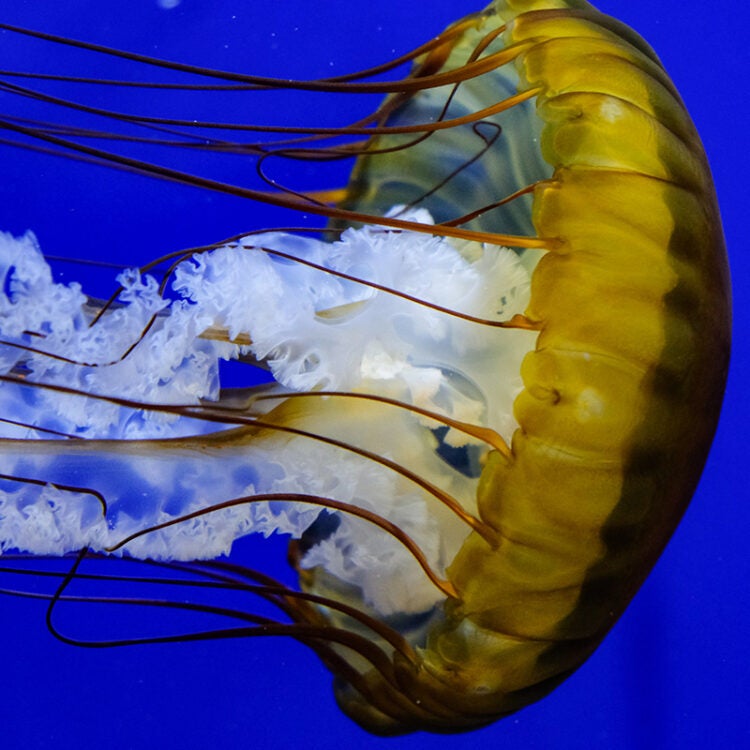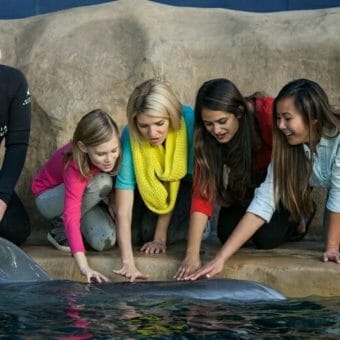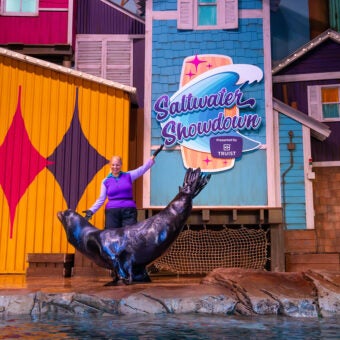-
Size
1-3 feet (0.3–0.9 m) -
Diet
Zooplankton -
Range
Pacific Ocean -
Habitat
Open ocean
Physical Characteristics
- A dome-shaped body called a “bell” that may measure 1-3 feet (0.3–0.9 m) in diameter.
- Bell is golden brown in color and has four ruffled oral arms extending down as much as 12 feet (3.7 m) from its underside.
- There are also about 24 to 40 thin, maroon tentacles extending downward from around the perimeter of the bell.
- This bell and tentacle body shape is the adult stage of the nettle, called a “medusa.”
Animal Fact
The bell and tentacle body shape is the adult stage of the Pacific sea nettle, called a “medusa.”
Diet / Feeding
- Diet consists of a wide variety of zooplankton including tiny crustaceans, invertebrate larvae, comb jellies, small fishes, fish eggs and larvae, as well as other jellies.
Range / Habitat
- Occurs in the coastal waters of California and Oregon, less common north to the Gulf of Alaska, west to Japan and south to the Baja Peninsula.
- Found in the largest numbers during fall and winter.
Reproduction & Growth
- Male and female sea nettles release sperm and eggs into the water daily during spawning periods.
- Fertilized eggs develop into larvae that drift and then settle to the bottom, attaching to hard surfaces, such as oyster shells.
- Larvae develop into small polyps that remain on the bottom in a dormant state throughout winter. During the spring and summer, the polyps “bud off” tiny sea nettles (called ephryae) about a quarter of an inch in diameter that grow rapidly into a medusa (adult stage).
- Sea nettles are made up mostly of water-containing salts with organic materials making up a small portion of their entire weight.
Conservation Status
- “Not Evaluated” on the IUCN Red List.
Additional Information
- Contact with the tentacles of this sea nettle can result in a painful sting. Some stings could be severe enough to require hospitalization.
- In some areas, the Pacific sea nettle population may become so large that jellies clog the nets of fishermen and block water intakes. These conditions can last for months.
- Some scientists believe human influences in coastal areas are creating conditions more favorable to jellies, leading to the increased frequency of large blooms.
- High concentrations of jellies are thought to reduce populations of larval fishes, resulting in lower commercial catches of adult fish.
- Natural predators include sea turtles, some sea birds and some fish species (such as Mola mola).
- The name Chrysaora has its origins in Greek mythology. Chrysaora was the son of Poseidon and Medusa and translates into “golden falchion” (a commonly used curved sword which could cut through armor), a reference to the stinging ability of these jellies.
- Also known as the brown sea nettle.
- A group of jellies is called a smack.
Sources
- http://jellieszone.com/chrysaora.htm
- www.mbayaq.org/efc/living_species
- www.aquariumofpacific.org/onlinelearningcenter/species_west_coast_sea_nettle






